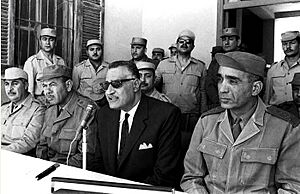Abdul Munim Riad facts for kids
Quick facts for kids
Abdul Munim Riad
|
|
|---|---|
 |
|
| Born | 22 October 1919 Tanta, Sultanate of Egypt |
| Died | 9 March 1969 (aged 49) Suez Canal zone, United Arab Republic |
| Allegiance | (1938–1953) (1953–1958) (1958–1969) |
| Years of service | 1938–1969 |
| Rank | Lieutenant general |
| Battles/wars | Second World War 1948 Arab–Israeli War Suez Crisis Six Day War War of Attrition † |
Abdul Munim Riad (born October 22, 1919 – died March 9, 1969) was a brave Egyptian army officer. He became the Chief of Staff for the Egyptian Armed Forces. He led soldiers in important wars, including the Six-Day War and the War of Attrition. Sadly, he was killed in action in 1969. The day he died, March 9, is now known as Egyptian Martyrs' Day in Egypt.
Contents
Early Life of Abdul Munim Riad
Abdul Munim Riad was born on October 22, 1919, in Tanta, a city in Egypt. His father, Mohammed Riad, was also a military officer. He taught at the Royal Military Academy.
Growing Up in Military Areas
In 1928, Riad's father was stationed in el-Arish. This area is in the Sinai Peninsula. Living there helped young Riad learn about the desert and mountains. He played with local Bedouin children. He also learned how to be a good scout.
In 1930, his family moved to Alexandria. His father became a colonel and led an infantry battalion. Riad finished high school in Alexandria in 1936. He then started medical school in Cairo. While in Cairo, he joined student protests. These protests wanted to end British influence in Egypt.
Military Career Beginnings
Later in 1936, the Anglo-Egyptian Treaty was signed. This treaty allowed more people to join Egypt's military academies. Riad decided to follow his dream of a military career. He joined the Royal Military Academy on October 6.
Training and Early Service
At the academy, he met other future leaders. These included Gamal Abdel Nasser and Anwar Sadat. Riad was known for being strong and smart. He worked hard to improve his skills. In 1938, he graduated with high honors. He specialized in anti-aircraft weapons. His dean praised him as an excellent student.
As a second lieutenant, Riad joined a new air defense unit. He learned a lot about weapons and how to hit targets in the air. He also improved his English skills.
World War II Service
When World War II started in 1939, Riad was promoted. He became a first lieutenant. He was in charge of anti-aircraft gun crews in Alexandria. He also taught at the Abbasia Barracks Artillery School. He often led his students to the front lines. His excellent work during the war was noticed. He was chosen to attend the General Staff College in Cairo. In 1944, he earned a Master's Degree in Military Science.
Leadership Roles and Achievements
After the 1952 revolution in Egypt, Riad took on more important roles. In 1960, he became the Chief of Staff for the Artillery Corps. He also advised the Air Force on air defense.

Rising Through the Ranks
From 1962 to 1963, he attended a special training session. In 1964, he became Chief of Staff of the Consolidated Arab Command. He was promoted to Lieutenant General in 1966. He also received many awards for his service. These included the Long Service Medal and the Order of Merit.
In May 1967, General Riad was sent to Amman, Jordan. He was appointed commander there. When the 1967 war (also known as the Six-Day War) began, he led the front in Jordan. After the war, on June 11, he became the Chief of Staff of the Armed Forces for Egypt. He worked hard to rebuild and organize the army. In 1968, he also became Assistant Secretary General of the League of Arab States.
Victories in the War of Attrition
During the War of Attrition, General Riad led Egyptian forces to several important wins. He stopped Israeli forces from taking Port Fuad. This city is located on the Suez Canal. He also oversaw the sinking of the Israeli destroyer Eilat in October 1967. Under his command, several Israeli warplanes were shot down in 1967 and 1968.
Death of Abdul Munim Riad
General Riad was in charge of a plan to destroy the Bar Lev Line. This was a line of Israeli defenses. He wanted to see how the plan was working. So, on March 8, 1969, Egyptian forces launched a strong attack. They caused a lot of damage to the Bar Lev Line.
On the morning of March 9, 1969, Riad went to the front line. He wanted to see the results of the battle himself. While he was there, Israeli forces opened fire. A mortar shell hit his location. General Riad and several of his helpers were killed.
Legacy of Abdul Munim Riad


After his death, President Gamal Abdel Nasser gave him Egypt's highest military award. This was the First Star Honors Military Rank. March 9 is now a special day in Egypt. It is a day to remember Abdul Munim Riad and other brave soldiers. One of Egypt's most famous squares is named after him. A street in Mohandessin, Cairo, also carries his name.

